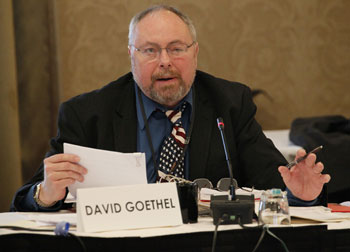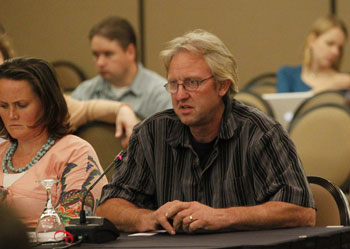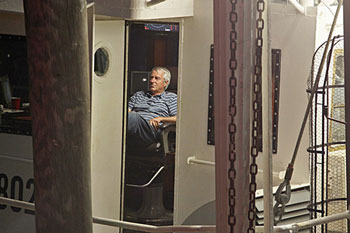OBSERVERS ON HERRING FLEET CLOSED AREAS
STILL OPEN
continued from Home Page

L to R: Dan Morris, NMFS Attorney; Paul Howard, NMFS, Sam Rauch, Acting Head NOAA Fisheries, Rip Cunningham, NEFMC member; Jim Odlin, vessel owner. Concerns about the overall health of the herring resource led to the development of Amendment 5. These concerns are reflected in the unprecedented level of interest in managing this fishery by New England’s commercial and recreational fishermen, eco-tourism and shoreside businesses, and the general public. ©Photo by Sam Murfitt
Commercial Striped Bass Association, said that, when herring trawlers enter the waters where his cohort fishes, they “clean the place out” and leave behind dead striped bass and groundfish.
“This is about small communities, small-boat fishermen, the tens of thousands of small-boat fishermen in New England,” Saletta said. “I know there’s a lot of money involved, but there are a lot of families and a lot of fishermen involved, too.”
One herring fisherman said that he and others he knew favored full observer coverage in order to clear the air of “all the lies spoken over the years.”
He continued, “Give us 100 percent coverage. We want it, we will clear the air.”
One herring processor said he was against full observer coverage. “We’re not about to destroy the environment,” he said. “We’re out to have a sustainable fishery.” He said there’s no documented evidence that herring trawlers are catching significant groundfish bycatch. He said he was concerned that, if forced to pay for observers, smaller Category A/B boats would go out of business, unable to afford the additional cost.
“The smaller boats particularly cannot afford it.”
Once the small boats go out of business, he said, there will be too few people catching the resource, and that will put processors out of business as well.
NEFMC agreed to delete Category C from the observer requirement. NEFMC members debated whether the $325 figure was appropriate. NEFMC member David Pierce said the NEFMC should support the $325 figure because the herring industry has been working cooperatively to develop the concept and supported that figure.
NEFMC member David Goethel said the NEFMC should consider reviewing the observer program after two years. “Do we want to saddle people with this in perpetuity?” Goethel asked.

NEFMC member David Goethel said the NEFMC should consider reviewing the observer program after two years. “Do we want to saddle people with this in perpetuity?” ©Photo by Sam Murfitt
NEFMC members also tackled the question of whether vessels would be allowed to fish if no observer were onboard. “We can’t reasonably require 100 percent coverage if it’s not clear there will be agency money,” said NEFMC member Mary Beth Tooley.
“My understanding is that 100 percent means 100 percent,” responded NEFMC member Tom Dempsey, who noted that NEFMC has previously imposed requirements that require industry funding, such as the purchase of vessel monitoring systems.
Fishery analyst Steele said it will be imperative for NEFMC to recognize that industry funding for observers will probably not go online in time for the start of the next fishing year, on Jan. 1, 2013.
NMFS Acting Regional Administrator Dan Morris said the full coverage program was important.
“We welcome the increase in monitoring,” Morris said. Working out the funding and implementation details could take time, he said.
“These are big changes in how we’re doing business,” Morris said. “That takes a long time. Six months is too optimistic. Once those details are worked out there will need to be supporting action from NEFMC to adopt those details…I don’t want to speculate on exactly how long that will be. But I have trouble seeing any of that bearing fruit in 2013.”
“It’s not the invasion of Normandy,” responded Dempsey. “We know how to do this. It’s just details to work out. I don’t see implementation being as big a challenge as others do.”
The NEFMC voted to adopt a timeline for setting up an observer program within a year of the adoption of Amendment 5. All other components of Amendment 5 will be ready to implement by Jan. 1, 2013, said Steele.
NEFMC also voted to adopt the waiver provision. And they agreed to review the observer program two years after its implementation.
“It wasn’t the intention to shut down the industry,” said a NEFMC member. “The intention was to have a deadline for management measures that will ultimately improve the fishery.”

Port Cyde fisherman Gary Libby (above) said he supported the concept of a buffer zone to protect river herring in the spring. He said he also favored catch caps. Lori Steele said the NEFMC received 48,000 comments on river herring, the “vast majority” of which supported the immediate conservation of river herring. ©Photo by Sam Murfitt
River Herring
After the vote to implement full observer coverage, the NEFMC debated whether further measures were needed to protect river herring, through measures such as monitoring/avoidance programs and catch caps. There was no specific number associated with what a catch cap might be on river herring, which shows up as bycatch in the Atlantic herring directed fishery.
“Do the catch monitoring measures adopted by the NEFMC in Amendment 5 so far adequately address concerns about river herring bycatch at this time? If not, what specific concerns/issues should be further addressed through measures adopted in this section?” Steele asked.
NEFMC members said they supported a collaborative project between the Sustainable Fisheries Coalition, the Massachusetts Department of Marine Fisheries, and the University of Massachusetts’ School for Marine Science and Technology, initiated with industry cooperation on an experimental basis to identify river herring hotspots.
One man said that, along his Massachusetts watershed, the number of river herring has taken a precipitous drop in the 15 years his community has monitored them.
“Whatever can be done to sustain this portion of the ecosystem would be greatly appreciated,” he said.
Port Cyde fisherman Gary Libby said he supported the concept of a buffer zone to protect river herring in the spring. He said he also favored catch caps.
Steele said the NEFMC received 48,000 comments on river herring, the “vast majority” of which supported the immediate conservation of river herring through some measures, and about half specifically addressing the need for an immediate catch cap.
A commercial fisherman from Cape Cod said the river herring population has dropped so much in his area that bycatch is hardly an issue. He said the only way to protect river herring there would be to close the inshore area to herring fishing all together.
“I think it’s important to do something like that, because what’s happened with river herring is a calamity, and people are responsible,” he said. “We’ve already had a calamity, and I think the only way to negate it would be not to have the seiners so close to the shore on the back side of the cape.”
Pierce said that additional protection should be provided for river herring in combination with the “hotspot” research. “It’s still being explored as a measure that could reduce bycatch of river herring,” Pierce said of the research. For example, he said, research indicates that the east side of Cape Cod is a hotspot for river herring at certain times of the year. “That’s an area where we can continue to expect high bycatch of river herring that will not be avoided by any other approach,” Pierce said. “It needs to be a river herring protection area.”
Dempsey said the bycatch avoidance approach “has a tremendous amount of merit and has potential, if linked with a cap, to allow the industry the flexibility to manage that.”

Glen Robbins, captain of the vessel Western Sea. “Why would you let other boats that can tow on bottom go in that area (closed area)? They do catch groundfish. They can make the mesh bigger, but the vibrations keep the fish in. Closed is closed.” ©Photo by Sam Murfitt
One man noted that, because the fish move around, interactions with fishing boats are not static. Instead, he said, “it’s a matter of making sure the industry has the tools to avoid interactions.”
In the end, the NEMFC approved a bycatch-avoidance approach coupled with the hotspot research.
When it came to the concept of a catch cap, however, the NEFMC found itself challenged by procedural issues. NEFMC attorney Gene Martin advised that a cap could not be specified before a framework was established for the specification process.
The NEFMC agreed simply to approve the development of a catch cap in “the next appropriate action.” The NEFMC considered whether to allow midwater trawl access to groundfish closed areas. During the public comment period, some environmental organizations said that the only exception to the groundfish closed areas should be under an experimental fishery permit for experimental/scientific purposes.
Some commenters suggested that midwater trawl fishing in groundfish closed areas should only be allowed if observers are aboard the vessels going into closed groundfish areas 100 percent of the time.
Again, Steele noted that, because NEFMC already approved full observer coverage for Category A/B vessels, the measure, by default, applies to groundfish closed areas as well.
Kaelin said the measure was unnecessary and based on a campaign of “allegation.”
“We’re not having an impact on groundfish” either inside or outside the closed areas. But charterboat operator Barry Gibson disagreed. He said that haddock bycatch incidents in 2008, in a groundfish closed area off Cape Cod, showed that herring trawlers are capable of catching groundfish.
“No groundfish are being conserved by just upping observer coverage,” Gibson said.
“Allowing them access is not fair and the groundfish guys have been paying the price for a long time,” said another fisherman.
Glen Robbins, captain of the herring vessel Western Sea, asked, “Why would you let other boats that can tow on bottom go in that area? They do catch groundfish. They can make the mesh bigger, but the vibrations keep the fish in. Closed is closed.”
In the end, the NEFMC voted on a measure to close year-round groundfish closed areas to midwater trawl vessels that are not declared out of the herring fishery, except for those with experimental fishing permit.
With the selection of final management measures for Amendment 5, the document will next be submitted to NMFS during July/August, and the approved management measures will become effective as quickly as the rulemaking process allows.
The NEFMC intends for Amendment 5 to be implemented as close to the start of the 2013 fishing year as possible. The next fishing year starts on Jan. 1, 2013.
